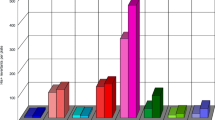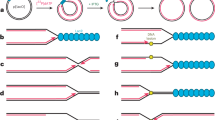Summary
An investigation has been carried out on the heritable changes caused by the incorporation of 5-bromouracil (BU) into the DNA of a number of amino acid-requiring derivatives of a thymineless mutant ofEscherichia coli 15. Results revealed that the number of mutations induced by the analogue was linearly related to the amount of BU incorporated into DNA. DNA replication was necessary in the presence of BU for the induction of mutations, but concomitant RNA and protein synthesis were not necessary. Induced revertants were found to arise in either one of two distinct patterns: 1. in a single burst one replication after incorporation of BU, with no further increase upon subsequent DNA replication, and 2. continually with each additional DNA replication. Based on theFreese theory, these patterns allowed tentative identification of the base pairs involved. Further, the number of DNA replications necessary for the expression of BU induced reversions was determined. It was found that a transition from A:T to G:C required two DNA replications in addition to incorporation of BU, while the transition C:G to A:T required only one. Results obtained by the use of BU were compared with results obtained using AP. It was found that the pattern of mutant induction and the number of DNA replications necessary for the expression of each mutant were the same with AP as with BU. This implied that AP preferentially replaces adenine. As the number of DNA replications necessary for the expression of BU-and AP-induced reversions was the same for each mutant tested, it was concluded that both strands of the DNA molecule were necessary to carry the genetic message. An attempt was made to synchronize the replication of DNA and, thereby to synchronize the appearance of mutations during one replication cycle. Revertants, however, occurred uniformly throughout the cycle. The results were further discussed in relation to existing models of DNA replication.
Similar content being viewed by others
References
Barner, H. D., andS. S. Cohen: The induction of thymine synthesis by T 2 infection of a thymine requiring mutant ofEscherichia coli. J. Bact.68, 80–88 (1954).
——: Synchronization of a thymineless mutant ofEscherichia coli. J. Bact.72, 115–123 (1956).
Bautz, E., andE. Freese: On the mutagenic effect of alkylating agents. Proc. nat. Acad. Sci. (Wash.)46 1584–1594 (1960).
Bendich, A., H. B. Pahl andG. B. Brown: Chromatographic fractionation ofE. coli DNA containing 5-bromouracil-2-C14. In: The chemical basis of heredity, pp. 378–396. Baltimore: Johns Hopkins Press 1957.
Bonner, J., C. H. Ru-Chih andN. Maheshwari: The physical state of newly synthesized RNA. Proc. nat. Acad. Sci. (Wash.)47, 1548–1560 (1961).
Brenner, S., andJ. D. Smith: Induction of mutations in the deoxyribonucleic acid of phage T 2 synthesized in the presence of chloramphenicol. Virology8, 124–129 (1959).
Cavalieri, L. F., andB. H. Rosenberg: The replication of DNA. II. The number of polynucleotide strands in the conserved limit of DNA. Biophys. J.1, 323–336 (1961).
Djordjevic, B., andW. Szybalski: Genetics of human cell lines. III. Incorporation of 5-bromo and 5-iododeoxyuridine into the deoxyribonucleic acid of human cells and its effect on radiation sensitivity. J. exp. Med.112, 509–531 (1960).
Dunn, D. B., andJ. D. Smith: Incorporation of halogenated pyrimidines into the deoxyribonucleic acids ofBacterium coli and its bacteriophages. Nature (Lond.)174, 305–306 (1954).
Freese, E.: The difference between spontaneous and base-analogue induced mutations of phage T 4. Proc. nat. Acad. Sci. (Wash.)45, 622–633 (1959).
Freese, E.: The molecular mechanisms of mutations. Vth Internat. Congr. Biochem. Moscow 1961.
Glass, E. A., andA. Novick: Induction of mutation in chloramphenicolinhibited bacteria. J. Bact.77, 10–16 (1959).
Gottschling, H., andE. Freese: Incorporation of 2-aminopurine into the desoxyribonucleic acid of bacteria and bacteriophages. Z. Naturforsch.16b, 515 (1961).
Hurwitz, J., A. Bresler andR. Diringer: The enzymic incorporation of ribonucleotides into polyribonucleotides and the effect of DNA. Biochem. biophys. Res. Commun.3, 15–19 (1960).
Litman, R. M., andA. B. Pardee: The induction of mutants of bacteriophage T 2 by 5-bromouracil. II. Nutritional and structural evidence regarding mutagenic action. Biochim. biophys. Acta42, 117–130 (1960).
Maaloe, O., andP. C. Hanawalt: Thymine deficiency and the normal DNA replication cycle I. J. molec. Biol.3, 144–155 (1961).
Margolin, P., andF. Mukai: The pattern of mutagen-induced back mutations inSalmonella typhimurium. Z. Vererb-Lehre92, 330–335 (1961).
Maruyama, Y., andT. Yanagita: Physical methods for obtaining synchronous culture ofEscherichia coli. J. Bact.71, 542–546 (1956).
Meselson, M., andF. W. Stahl: The replication of DNA inEscherichia coli Proc. nat. Acad. Sci. (Wash.)44, 671–682 (1958).
Nakada, D., E. Strelzoff, R. Rudner andF. J. Ryan: Is DNA replication a necessary condition for mutation? Z. Vererb.-Lehre91, 210–213 (1960).
Peŕkel, M. S.: Personal communication 1961.
Robinow, C. F.: Nuclear apparatus and cell structure of rod-shaped bacteria. InR. J. Dubos (edit.), The bacterial cell, pp. 355–377. Cambridge, Mass.: Harvard University Press 1945.
Rudner, R.: Mutation as an error in base pairing. I. The mutagenicity of base analogues and their incorporation into the DNA ofSalmonella typhimurium. Z. Vererb.-Lehre92, 336–360 (1961a).
—: Mutation as an error in base pairing. II. Kinetics of 5-bromodeoxyuridine and 2-aminopurine-induced mutagenesis. Z. Vererb.-Lehre92, 361–379 (1961b).
Ryan, F. J.: Spontaneous mutation in non-dividing bacteria. Genetics40, 726–738 (1955).
—: Bacterial mutation in a stationary phase and the question of cell turnover. J. gen. Microbiol.21, 530–549 (1959).
—,D. Nakada andM. J. Schneider: Is DNA replication a necessary condition for spontaneous mutation? Z. Vererb.-Lehre92, 38–41 (1961).
— andL. K. Wainwright: Nuclear segregation and the growth of clones of spontaneous mutants of bacteria. J. gen. Microbiol.11, 364–379 (1954).
Schulman, H. M.: Unusual nucleic acid fraction fromNeurospora crassa. Science134, 1434 (1961).
Shapiro, H. S., andE. Chargaff: Severe distortion by 5-bromouracil of the sequence characteristics of a bacterial deoxyribonucleic acid. Nature (Lond.)188, 62–63 (1960).
Sinsheimer, R. L.: Bacteriophage with single-standed deoxyribonucleic acid. Fed. Proc.20, 661–664 (1961).
Spiegelman, S., B. D. Hall andR. Storck: The occurrence of natural DNA-RNA complexes inE. coli infected with T2. Proc. nat. Acad. Sci. (Wash.)47, 1135–1140 (1961).
Strelzoff, E.: DNA synthesis and induced mutations in the presence of 5-bromouracil. I. Z. Vererb.-Lehre93, 287–300 (1962).
Strelzoff, E.: Unpublished data (1962b).
Wacker, A.: Personal communications 1961.
—,S. Kirschfeld andL. Träger: Über den Einbau purinanaloger Verbindungen in die Bakterien-Nukleinsäure. J. molec. Biol.2, 241–242 (1960).
Watson, J. D., andF. H. C. Crick: Studies on lysogenization inEscherichia coli. Cold Spr. Harb. Symp. quant. Biol.18, 71–73 (1953).
Weiss, S. B.: Enzymatic incorporation of ribonucleoside triphosphates into the interpolynucleotide linkages of ribonucleic acid. Proc. nat. Acad. Sci. (Wash.)46, 1020–1030 (1960).
Zamenhof, S.: Further studies on the unstable and “unnatural” deoxyribonucleic acids. Ann. N.Y. Acad. Sci.81, 784–787 (1959).
—, andG. Griboff: Incorporation of halogenated pyrimidines into the deoxyribonucleic acids ofBacterium coli. Nature (Lond.)174, 306ff. (1954).
—,B. Reiner, R. de Giovanni andK. Rich: Introduction of unnatural pyrimidines into deoxyribonucleic acid ofEscherichia coli. J. biol. Chem.219, 165–173 (1956).
Author information
Authors and Affiliations
Additional information
With 10 Figures in the Text
Supported in part by grants from the American Cancer Society, the U.S. Public Health Service and the National Science Foundation administered by ProfessorF. J. Ryan.
Rights and permissions
About this article
Cite this article
Strelzoff, E. DNA synthesis and induced mutations in the presence of 5-bromouracil II. Induction of mutations. Zeitschrift für Vererbungslehre 93, 301–318 (1962). https://doi.org/10.1007/BF00889172
Received:
Issue Date:
DOI: https://doi.org/10.1007/BF00889172




